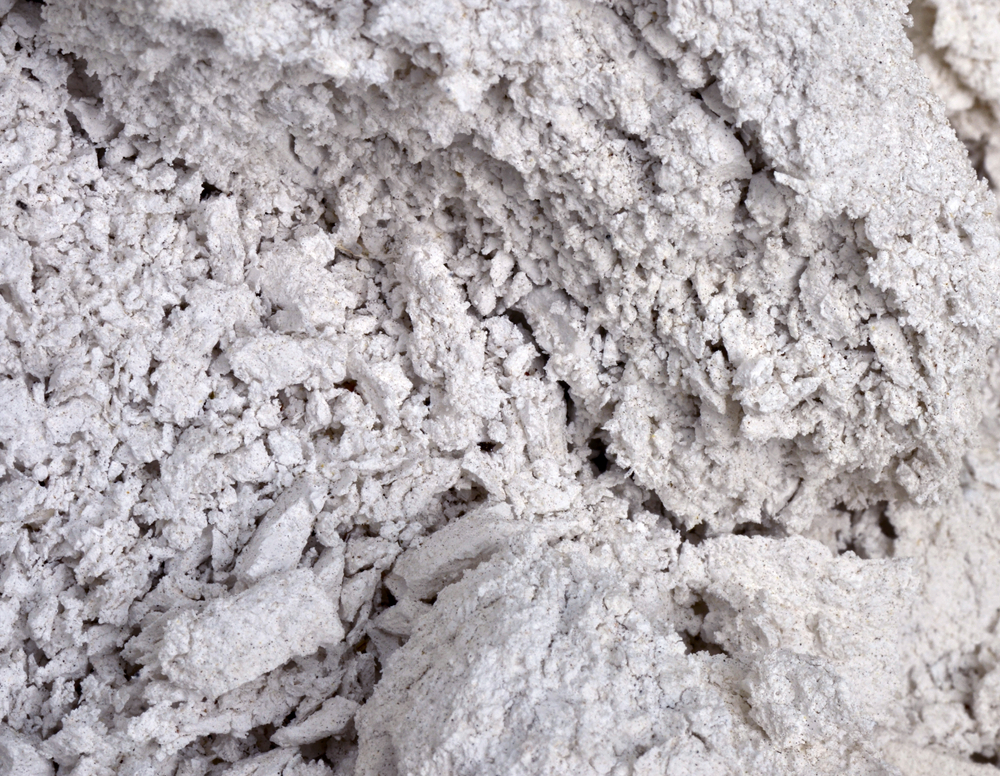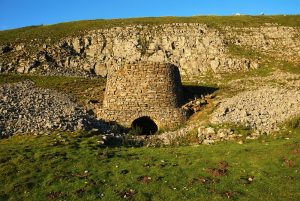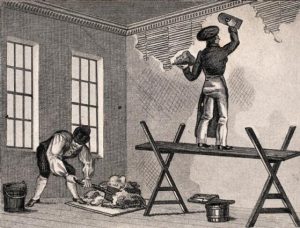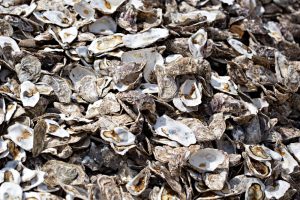
Materials of Sleep: Lime
In this fourth post for our mini-series on materials of sleep, Dr Holly Fletcher examines the significance of lime for creating healthy sleeping environments in early modern England and early America.

A lime kiln in the Yorkshire Dales
Lime is a versatile mineral commonly created by burning limestone (calcium carbonate) to produce quicklime (calcium oxide) which, through the addition of water, becomes slaked lime (calcium hydroxide). Lime has been used as a building material for thousands of years and is discussed in texts by both Pliny the Elder and the Roman architect Vitruvius. In the early modern period, lime was used in increasing quantities, mainly in construction and agriculture but also for craft work (e.g. tanning leather) and for medicinal purposes. Virtually every major building project in early modern England had a dedicated lime kiln, and by 1700 the use of lime was almost universal among English farmers.¹ Lime’s widespread use shaped the landscape through limestone quarrying, the construction of lime kilns, and efforts to source limestone in regions which did not have a ready supply.

Application of plaster to walls, engraving (date unknown). Wellcome Collection.
A lesser-known fact about lime is that it was also used to create healthy sleep environments. Firstly, its use in mortar and plaster helped to produce comfortable homes which were sturdy, weather-proof and damp-resistant, all of which contributed to a good night’s sleep. Lime plaster in particular was understood to moderate the temperature within the home, including the bedroom. In 1736, for instance, the English writer and scientist John Harris commented on the common presence of ‘plaistered Ceilings’ in England, of which lime was a key component. He stated that ‘in Summer-time, the Air of a Room is something the cooler for them, and in the Winter, something the warmer’. The ability of lime to regulate temperature, helping to insulate a house while also allowing it to ‘breathe’ through its vapour-permeable qualities, made it a crucial material for sleeping well.² Early modern people tried to ensure the temperature within the bedroom remained cool and fresh, as overheated sleeping chambers were thought both to prevent the onset of sleep and to cause disease. Equally, extreme cold could stop a person from falling asleep, and was combatted through bed-warmers and fires during the winter months.³ The use of lime plaster would have assisted with such efforts to create a healthy temperature for sleep.

Engraving of a flea, in Robert Hooke, Micrographia: or some physiological descriptions of minute bodies made by magnifying glasses with observations and Inquiries thereupon, 1665. Wellcome Collection.
The use of lime for sleeping well was explicitly noted by early modern commentators in relation to the removal of pests such as bedbugs and fleas. Thomas Moffett’s posthumous Theatre of Insects (1658) described how to smoke out bedbugs ‘with the curtains drawn about the bed, so to shut in the smoke’. For this purpose, he stated ‘unguents, oyntments [and] embrocations’ should be made using a variety of substances, including lime. Similarly, Moffett wrote of fleas that ‘molest men that are sleeping’ by hiding in blankets and bedclothes. To ‘destroy’ the fleas, he recommended sprinkling ‘quicklime mingled with the juice of white Hellebore’ about the bedchamber. English merchant and writer Thomas Tryon noted that lime plaster itself could deter pests and he dismissed beliefs that bedbugs were generated by the plastering of walls with a mixture of hog’s hair and lime. Not only did he reject the idea that hair could generate insects, but he stated that the mixture of hair with lime ‘totally destroyed’ any possibility of such generation: ‘For Lime does chiefly contain a harsh, fiery, keen, sharp, corroding Quality; it is so sharp, that it does destroy all Life, and is as contrary to it, as Light is to Darkness’, making such plaster an inhospitable environment for pests.
Other uses of lime in the bedroom included light production. French chemist Nicholas Lémery recommended mixing quicklime with water in a vial to ‘make a light in a chamber at night’. Some may also have used lime to whiten their bedsheets, though English naturalist Robert Lovell warned against whitening linen with lime because it ‘biteth and causeth scabbiness’. Finally, the widespread use of lime as plant fertiliser meant that it was involved in the cultivation of numerous botanicals that were used to promote healthy sleep. Returning to bedroom pests, for instance, Thomas Moffett recommended ‘winter Cherries laid near the bed, or hanged up [to] drive away Wall-lice’, another term for bedbugs. Meanwhile, drawing on Pliny the Elder, the naturalist Robert Plot stated that laying lime at the roots of cherry trees ‘hastens the ripening of their fruit’, indicating how lime could be an essential nutrient for sleep-friendly plants.
Lime assisted with healthy sleep through various means, therefore, yet its effective use also depended on its quality. Not all lime was the same. In his Natural History of Northamptonshire (1712) John Morton wrote that ‘the Lime made at Wood-End nigh Blaxly is preferr’d to that of the Neighbouring Lime-Kilns’. The quality of lime was determined by the quality of the limestone that was burnt to create it, as Morton stated, ‘the hardest Lime stone, as they find by Experience at Cortenhall (a Place affording great variety of Limestone) and indeed in all other Places, burns to the strongest Lime’. Different kinds of lime made from different limestone could then be used for varied purposes. Softer, ‘fatter’ lime could be used for the internal plastering of a building, whilst harder, ‘leaner’ lime would be applied externally. As the kind of limestone used for making lime varied according to geographic location, the sleeping environments created through the use of such lime would also have varied.
 This is particularly interesting in the context of the emerging English colonies in North America, where limestone was more difficult for colonists to obtain than in England. Limestone and chalk were initially imported to Virginia, yet it was not long before an alternative source of lime was sought. In place of limestone, to produce calcium oxide colonists burned oyster shells, which were an abundant local resource. Archaeological evidence from historic Jamestown shows that oyster shell mortar was relied upon for the development of the Jamestown colony. The use of shells for this purpose was not unprecedented. Oyster shell lime was known to be used in the Netherlands, and the Scottish physician and botanist James Wallace described how the main source of lime in the Orkney Islands was cockle shells. He stated that the process ‘makes a very fair Lime, and does very well in Plaister, though I doubt whether it be so proper for Building as stone Lime is’.
This is particularly interesting in the context of the emerging English colonies in North America, where limestone was more difficult for colonists to obtain than in England. Limestone and chalk were initially imported to Virginia, yet it was not long before an alternative source of lime was sought. In place of limestone, to produce calcium oxide colonists burned oyster shells, which were an abundant local resource. Archaeological evidence from historic Jamestown shows that oyster shell mortar was relied upon for the development of the Jamestown colony. The use of shells for this purpose was not unprecedented. Oyster shell lime was known to be used in the Netherlands, and the Scottish physician and botanist James Wallace described how the main source of lime in the Orkney Islands was cockle shells. He stated that the process ‘makes a very fair Lime, and does very well in Plaister, though I doubt whether it be so proper for Building as stone Lime is’.
Wallace was not the only one to question the use of shell-based lime for building. In the transactions of the Royal Society from 1748, John Mitchell wrote of the American ‘way of making lime of shells, the only lime they use in most places’. He described the burning of oyster shells between a pile of wood, also known as a lime rick.4 ‘The lime, thus made’, Mitchell stated, ‘is reckoned very good; but as it is impregnated with the ashes of the wood, and the marine salt that is often in the shells, it is apt to make the houses that are built with it very damp in moist weather; so that the water often runs down the walls in streams; which cannot but be very unwholesome in an air that is naturally close and damp’.
According to Mitchell, therefore, the lime colonists made from oyster shells was not only inferior to that made from limestone, but was unhealthy or ‘unwholesome’, particularly in the humid climate of North America. The interaction of oyster shell lime with the American climate was thus thought to generate unhealthy living conditions – conditions that were known to damage sleep quality. While simply being in a home with moisture running down the walls would have been viewed as unhealthy, sleeping in such a setting was especially dangerous since, during sleep, the body was thought to be particularly vulnerable to disease.
Lime contributed to healthy sleep in several ways, yet it’s effectiveness in doing so was understood to depend on the climate in which it was used and the materials it was made from, which themselves varied according to the environments from which they were sourced. By examining the significance of lime, therefore, it is clear that efforts to sleep well involved the close interaction of early modern people with their material environments. Moreover, from the example of lime we may begin to see how the creation of healthy sleeping environments could be embedded in wider material processes which actively shaped the landscapes and ecologies of early modern England and colonial America.
1 David Johnson, ‘Hushes, Delfs and River Stonary: Alternative Methods of Obtaining Lime in the Gritstone Pennines in the Early Modern Period’, Landscape History 31 (2010), p. 49 & John F. Richards, The Unending Frontier: An Environmental History of the Early Modern World (University of California Press, 2003), p. 237
2 On the uses and properties of lime for insulation see: Andrew Thomson, Kris Dick & Pete Walter, ‘Steady-state and dynamic hygrothermal performance of rendered straw bale walls’, Proceedings of the Institution of Civil Engineers – Construction Materials 174 (2021) & A. Evrard & A. De Herde, ‘Hygrothermal Performance of Lime-Hemp Wall Assemblies’, Journal of Building Physics 34 (2010).
3 Sasha Handley, Sleep in Early Modern England, (Yale University Press, 2016), pp. 46-48.
4 The George Washington Foundation reconstructed the burning of oyster shells in a lime rick which can be viewed here: https://www.youtube.com/watch?v=tDuDGyYA7pQ








0 Comments